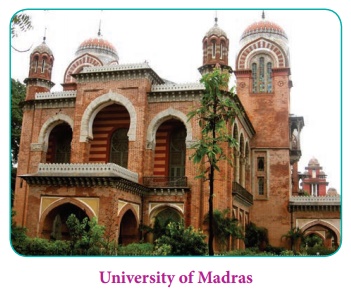Rise of Nationalism in India | History - Western Education and its Impact | 12th History : Chapter 1 : Rise of Nationalism in India
Chapter: 12th History : Chapter 1 : Rise of Nationalism in India
Western Education and its Impact
Western Education and its Impact
(a) Education in Pre-British India
Education
in pre-colonial India was characterised by segmentation along religious and
caste lines. Among the Hindus, Brahmins had the exclusive privilege to acquire
higher religious and philosophical knowledge. They monopolised the education
system and occupied positions in the society, primarily as priests and
teachers. They studied in special seminaries such as Vidyalayas and Chatuspathis.
The medium of instruction was Sanskrit, which was considered as the sacred
language. Technical knowledge – especially in relation to architecture,
metallurgy, etc. – was passed hereditarily. This came in the way of innovation.
Another shortcoming of this system was that it barred women, lower castes and
other under-privileged people from accessing education. The emphasis on rote
learning was another impediment to innovation.
(b) Contribution of Colonial State: Macaulay System of Education
The
colonial government aided the spread of modern education in India for a
different reason than educating and empowering the Indians. To administer a
large colony like India, the British needed a large number of personnel to work
for them. It was impossible for the British to import the educated lot, needed
in such large numbers, from Britain. With this aim, the English Education Act
was passed by the Council of India in 1835. T.B. Macaulay drafted this system
of education introduced in India. Consequently, the colonial administration
started schools, colleges and universities, imparting English and modern
education, in India. Universities were established in Bombay, Madras and
Calcutta in 1857. The colonial government expected this section of educated
Indians to be loyal to the British and act as the pillars of the British Raj.
T. B. Macaulay was India’s first law member of the Governor
General in Council from 1834 to 1838. Before Macaulay arrived in India the General
Committee of Public Instruction was formed in 1823 with the responsibility to
guide the East India Company on the matter of education and the medium of
instruction. The Committee was split into two groups. The Orientalist group
advocated education in vernacular languages. The Anglicists advocated Western
education in English.

Macaulay was on the side of Anglicists and wrote his famous ‘Minute on Indian Education’ in 1835. In this Minute, he argued for Western education in the English language. His intention behind supporting the Anglicists was that he wanted to create a class of persons from within India who would 'be Indian in blood and colour, but English in taste, in opinion, in morals and in intellect'.
The
British created an educated Indian middle class for their own ends but sneered
at it as the Babu class. That very class, however, became the progressive
intelligentsia of India and played a leading role in mobilising the people for
the liberation of the country.

(c) Role of Educated Middle Class
The
economic and administrative transformation on the one side and the growth of
Western education on the other gave the space for the growth of new social
classes. From within these social classes, a modern Indian intelligentsia
emerged. The “neo-social classes” created by the British Raj, which included
the Indian trading and business communities, landlords, money lenders,
English-educated Indians employed in imperial subordinate services, lawyers and
doctors, initially adopted a positive approach towards the colonial
administration. However, soon they realised that their interests would be
better served only in independent India. People of the said social classes
began to play a prominent role in promoting patriotism amongst the people. The
consciousness of these classes found articulation in a number of associations
prior to the founding of the Indian National Congress at the national level.
Raja Ram
Mohan Roy, Ishwar Chandra Vidyasagar, Swami Vivekananda, Aurobindo Ghose,
Gopala Krishna Gokhale, Dadabhai Naoroji, Feroz Shah Mehta, Surendra Nath
Banerjea and others who belonged to modern Indian intelligentsia led the
social, religious and political movements in India. Educated Indians had
exposure to ideas of nationalism, democracy, socialism, etc. articulated by
John Locke, James Stuart Mill, Mazzini, Garibaldi, Rousseau, Thomas Paine, Marx
and other western intellectuals. The right of a free press, the right of free
speech and the right of association were the three inherent rights, which their
European counterparts held dear to their heart, and the educated Indians too
desired to cling to. Various forums came into existence, where people could
meet and discuss the issues affecting their interests. This became possible now
at the national level, due to the rapid expansion of transport network and
establishment of postal, telegraph and wireless services all over India.
(d) Contribution of Missionaries
One of
the earliest initiatives to impart modern education among Indians was taken up
by the Christian missionaries. Inspired by the proselytizing sprit, they
attacked polytheism and caste inequalities that were prevalent among the
Hindus. One of the methods adopted by the missionaries, to preach Christianity,
was through modern secular education. They provided opportunities to acquire
education to the underprivileged and the marginalised sections, who were denied
learning opportunities in the traditional education system. However only a very
small fraction converted to Christianity. But the challenge posed by
Christianity led to various social and religious reform movements.

Related Topics